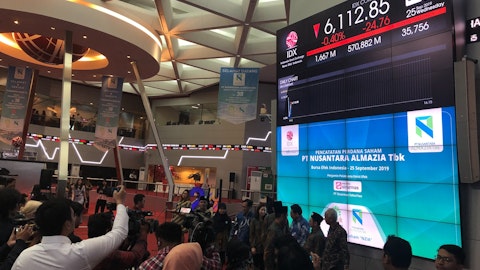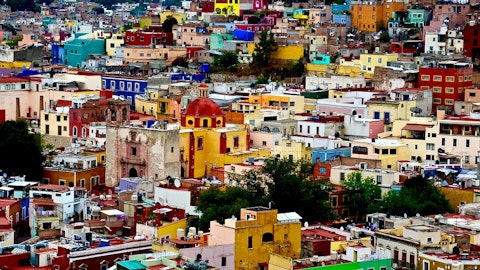Marvin Fong: Sure. And just my follow-up, a bigger picture question. I think it was a very strong quarter in terms of acquiring more fintech active users. And I was just curious beyond what you wrote in the shareholder letter, could you elaborate on what’s driving that? Was it more internal initiatives? Or do you think it was some component just from the broader economy and whatnot? So just would love some color there. Thank you very much.
Osvaldo Gimenez: So I think there are several factors contributing to that. One of those is our remunerated account [indiscernible] both in Argentina and in Brazil, which is doing very well. What we pay our users depends on what the risk-free rate is in each of the countries. In Brazil it’s around 13%; in Mexico around 10%. In Argentina, given recent spike in inflation and interest rate, it has been close to 100%. So this gives users a huge incentive to move out of banks with savings accounts, which many times pay zero, or only pay after 30 days, and move their money into Mercado Pago. I think that has been part of the driver. Another part of the driver, I think, has been, as we were saying, the increased availability and offering of credits that we’re giving out, in that case, I would say it’s mostly, in the case of – in Brazil and in Mexico, not so in Argentina, where we have been cautious given this rate environment.
Marvin Fong: Thank you very much. Appreciate the color.
Operator: And our next question comes from Trevor Young with Barclays. Trevor, go ahead.
Trevor Young: Great. Thanks. On the MELI Mas subscription plans, is there any color that you can share on initial subscriber counts here in the first four – two or three months, excuse me? Is that ramping as you expected? And then second question, can you give us an update on where we are in terms of logistics monetization? I realize you’ve indicated it will be gradual over a number of years, but just any update over the last few quarters would be helpful. Thank you.
Martin de los Santos: Thanks all for your questions, Martin here. I think it’s too early to tell. As Ari mentioned before, we launched this program a few months ago. We are seeing good engagement with the program as well as with the MELI Delivery Day, but it’s too early to share numbers in terms of adoption. I think in the coming quarters, we’ll be — we will share more information. But we are excited about the program. Ari?
Ariel Szarfsztejn: Yes, Trevor. So on monetizing shipping, I think our Q3 results and our year-to-date results show that we have been able to pull levers to offset some of the headwinds that we have in shipping from higher inflation rates in the logistics environment and higher fulfillment penetration that has helped us keep our total net shipping costs over GMV broadly stable in 2023. I mean, we still think that we have plenty of opportunities to improve our net shipping costs by focusing on productivity, efficiency, scale benefits, et cetera. But we also want to incentivize more sellers to use our fulfillment solutions, particularly in Brazil. So in all, there is potential to monetize fulfillment, specifically in the future if we decide to do so. But as we – we have always said, are not in a rush to do that. We are always mindful of what monetization might imply for consumer prices and competition. And we are happy with the way we are managing our P&L in general.
Trevor Young: That’s helpful. Thank you, both.
Operator: Thank you. And our next question comes from Geoffrey Elliott with Autonomous. Geoffrey, your line is open. Please go ahead.
Geoffrey Elliott: Hello. Thanks very much for taking the question. I wanted to touch on the off-line POS business in Brazil, it looks like fintech services take rates were down a little bit. We saw that you rolled out some pricing there that is cheaper for the merchant, but clearly, less beneficial for you, it looks, in terms of the MDRs that you’re charging. And the publicly traded competitors, obviously, stock prices are a fraction of what they were a couple of years ago. Can you just remind us, how does that off-line POS business fit with the rest of MELI? What is the synergy there? And then if you’re thinking out 5 years, 10 years, how is that going to fit into the rest of what you’re doing? Does it still really make sense for that business to be a focus? Or is it something that could become smaller over time or maybe doesn’t make sense to keep over time? Thank you.
Osvaldo Gimenez: Hi, Geoffrey. We see the POS business, the in-store business as a big part of our fintech offering. We allow merchants to charge with Mercado Pago offline. Some are very small merchants, some are SMBs, and even some are larger merchants. And we have been able to provide this solution in, I’d say, in a very profitable way, and we continue to do so. The profitability behind our POS business has been very good throughout the quarter. We have seen some — have to make some changes as we move upmarket. Some of that is related to what we saw in terms of changing our go-to-market strategy. As we attract larger merchants, in some cases, what we do is we offer lower processing fees. But we get — on the other hand, it’s better for the merchant because they get lower fees, as you said.
But it’s good for us too, because what we see is higher activation rate and higher TPV per device. So not necessarily we’re getting a lower margin in terms of margin on top of TPV, but we’re getting a larger margin per device sold. And so I think that this continues to be very good for us. I’d say I’d add to that on the POS front, in this quarter, we have been changing — making some changes beyond pricing in terms of our go-to-market strategy, and we are very encouraged by the results we’re seeing, again, in terms of activation and TPV per device.
Geoffrey Elliott: And the synergy with the rest of the business with this POS machine operation, where is that?
Osvaldo Gimenez: So we are offering, I would say, on two sides. On the one hand, is many merchants, they sell online, they sell offline, through MercadoLibre they sell through the POS. So there’s a synergy there in having pretty much all of their sales coming through Mercado Pago to them. . On the other hand, many of these merchants, in some cases, are individuals, and we are able to cross-sell different products to them and offer more banking products to them basically. So we offer them — it’s not only the device we’re giving them and the process we’re giving them. We’re offering them a credit where they invest in [indiscernible]. We have started to offer them a credit card to individuals based on the business they run. And so really is part of our banking solution, and there are many products we’re offering to them. There’s a good synergy between all of the rest of the banking products we offer.
Geoffrey Elliott: Great. Thanks very much.
Operator: Thank you. And our next question comes from Neha Agarwala with HSBC. Neha, your line is open. Please go ahead.
Neha Agarwala: Thank you so much and congratulations on the strong quarter. Just two quick questions. First, on the 1P business, we talked earlier in the year about some acceleration, gradual acceleration in the 1P business. How is that going? And what is the vision going forward? And my second question is on the credit quality. There was a little bit of an uptick for the early delinquencies. Could you explain to us where is that coming from? Despite some pickup in the loan growth, maybe Mexico is not doing as well. So if you could talk a little bit about the early delinquencies and about how the portfolio in Mexico is performing, that would be very helpful. Thank you so much.





